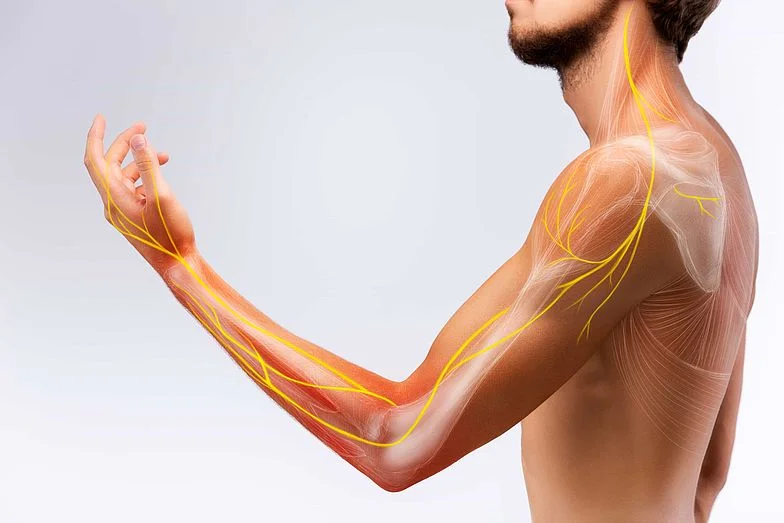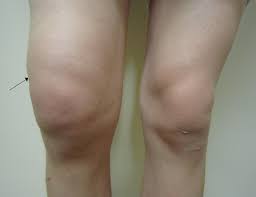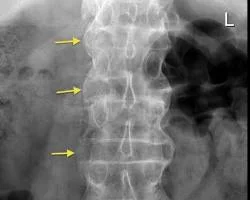Polyneuritis
What is Polyneuritis?
The simultaneous inflammation of several peripheral nerves throughout the body is the hallmark of a medical condition known as polyneuritis. Numerous symptoms, including numbness, discomfort, muscle weakness, and loss of reflexes, can be caused by this condition.
When these nerves become inflamed, it disrupts normal nerve function, leading to a range of symptoms such as numbness, tingling, pain, and muscle weakness.
Types of Neuritis
- Multiple neuritides or polyneuritis
- Brachial neuritis
- optic neuritis
- Also known as peripheral neuropathy,
- peripheral neuritis
- Neuropathic vestibular pain
- Bell’s palsy, also known as arsenic neuritis, is a common manifestation of cerebral neuritis
Often, only one nerve is affected rather than a widespread disruption of the nerves. However, occasionally the cause is a tumor pressing on the nerve or damage to the nerve from a gunshot, blow, or cut.
The sciatic nerve, a large nerve that descends from the spinal cord into the lower limb, can become inflamed or damaged. Additional causes include back pain, rheumatoid arthritis of the spine, or nerve strain from certain types of labor.
Neuritis of the Spinal Nerves: For example, chest pain associated with inflammation of the nerves between the ribs may be indicative of pleurisy or a true coronary blockage (heart attack). Additionally, there are several traumas or diseases that might affect the nerves that travel from the neck to the arm. For example, brachial paralysis is caused by excessive force applied to the fetus’s neck nerves during complicated obstetrical births.
Neuritis of the Cranial Nerves: Chewing, a draft of chilly air, and other variables can delay it.
Optic neuritis: Optic neuritis refers to any of the various conditions in the nerves that supply the retina of the eye; it can impair vision and necessitates rapid medical attention. The eighth cranial nerve, which aids in preserving the inner ear’s sense of balance, can occasionally sustain damage from the antibiotic streptomycin. Any abnormality that affects speech, swallowing, taste, hearing, vision, balance, or cranial nerves should be reported to a physician or healthcare professional very away.
Cause of Polyneuritis
Polyneuritis, or peripheral polyneuropathy, can result from various underlying conditions and factors. Some common causes include:
- Infection:
- Simplex herpes
- Shingles
- Guillain-Barre syndrome
- leprosy
- Chemical injuries
- Physical injury
- Medicines for radiation: Vinblastine, Pergolide, and Disulfiram
The following conditions can cause localized neuritis, which affects just one nerve:
- Diabetes,
- localized injury,
- Diphtheria
Underlying medical conditions can cause polyneuritis (pain affecting several nerves):
- Vitamin B12 Deficiency
- Beriberi
- metabolic diseases
- Diabetes
- Hypertension
- Porphyria
- Viral or bacterial infections
- An inflammatory disease, especially multiple sclerosis
- Alcoholism Alcohol
- Cancer
- Migratory sensory neuropathy of Wartenberg
Symptoms of polyneuritis
Polyneuritis presents with a range of symptoms due to the inflammation and dysfunction of multiple peripheral nerves. Common symptoms include:
- Numbness, tingling or tingly feelings, and “stinging” (also known as paraesthesia)
- Burning feeling in the hands or feet
- Abrupt onset of discomfort and extreme sensitivity to touch (sometimes referred to as allodynia).
- Weakness in the limb, possibly brought on by atrophy or weak muscles.
- Incapable of walking straight, easily stumbling or falling.
- Difficulty swallowing
Depending on the underlying cause, polyneuritis symptoms can vary, however the following are the most typical ones: tingling or tingling sensations, numbness, “stinging” (sometimes referred to as paraesthesia); lack of feeling in the legs and arms; burning feeling in the hands or feet; abrupt onset of pain; allodynia, or acute sensitivity to touch; limb weakness, potentially brought on by atrophy or weakening of the muscles; unable to walk steadily and prone to stumbling or falling; trouble swallowing.
Symptoms can vary in severity and may develop gradually or suddenly, depending on the underlying cause and progression of the condition.
Diagnosis
A thorough physical examination is the first step towards accurately diagnosing and characterizing neuritis, as it helps identify and pinpoint any symptoms of a specific nerve or distribution of nerves.
In addition to evaluating if the conditioning process impacts motor, sensory, or sensorimotor nerves, an examination will look at the time course, distribution, severity, and nerve dysfunction.
A more careful investigation may employ precise techniques appropriate for the affected nerves once the lesion has been localized.
Blood tests should be performed to detect serum B12 and blood glucose levels along with their metabolites. If the physical examination and record are consistent, additional assessments of specific vitamins or toxins may be performed. However, a number of disorders linked to neuritis are diagnosed clinically and do not require a specialized diagnostic test.
Treatment of Polyneuritis
Medical treatment
Topical medications such as creams like capsaicin, which can be applied to the affected area to cause either a loss of sensation or a hot pepper-like sensation, lidocaine patches on the skin, antidepressants such as doxepin, amitriptyline, and nortriptyline, which interfere with chemical reactions in the brain and spinal cord to relieve pain, duloxetine (Cymbalta), venlafaxine (Effexor XR), are some other antidepressants that help relieve the pain primarily caused by diabetes, anti-seizure medications such as pregabalin (Lyrica) and gabapentin (Neurontin, Gralise) have been proven to be helpful in treating epilepsy.
For the disorder, opioids such as tramadol (Ultram, Conzip) and oxycodone (Roxicodone, Oxycontin) are some additional pain relievers in case over-the-counter treatments don’t work. In addition to prescribing a wheelchair, walker, foot braces, or cane, the doctor may also recommend physical therapy as a means of relieving the patient’s discomfort and enhancing mobility.
IV immunoglobulin and plasma exchange therapy, which involves removing specific proteins and antibodies from the blood, as well as transcutaneous electrical nerve stimulation (TENS) therapy, which involves applying electrodes to the skin and passing mild electric current at various frequencies, can also be helpful in treating inflammatory conditions. When non-surgical methods fail, surgery might be used to relieve the pressure that tumors are placing on the nerves.
Physical therapy treatment
Although aerobic and flexibility exercises have many general benefits, patients with polyneuritis particularly need to increase their heart rate and range of motion. Engaging in physical activity helps improve blood circulation, which increases oxygen delivery to nerve tissues.
Go for a Walk
If you find it difficult to walk right now, start out slowly by going to the mailbox or a nearby location. A stroll is just the beginning.
Resistance Exercise
Not everyone is a bodybuilder, and that’s okay. Resistance exercise, whether it’s lifting five-pound weights or performing pushups or situps, can enhance blood flow and flexibility when included in everyday routines.
Stretching Increases Flexibility
Remember that your body needs to heal and that healing occurs when you continue to be active and allow blood to continue to flow.
Take a cue from the tortoise and the hare: perseverance is more important than speed when it comes to reaching your destination.
Enhancing symptoms is another purpose for a number of medicines. Based on the severity of a patient’s condition and their goals, doctors determine which therapy is ideal for a certain patient.
Complications of polyneuritis
Patients with chronic polyneuritis may burn themselves or cause an open injury to themselves without realizing it since they commonly lose the capacity to feel pain and warmth.
The individual may experience diarrhea or constipation, as well as a loss of bladder and bowel control if the affected nerves are located in the internal organs. Polyneuritis in extra also manifests as abnormally low blood pressure and disruption in sexual function.
Guillain-Barre syndrome is among polyneuropathy’s most serious complications. This is an acute, recurrent, progressive illness where nerves are attacked by the body’s immune system as soon as they leave the spinal cord. The patient will first experience tingling and weakness in one limb, then spread across the entire arm.
Guillian-Barre syndrome is a chronic disease called chronic polyneuritis. Since 30% of people are likely to require a wheelchair, early identification and treatment are crucial.
These entail controlling any underlying cause and maintaining a well-balanced diet. Regular exercise and the intake of vitamin B supplements can both help. There are other actions that can be taken, such as quitting smoking, managing stress, and consuming too much alcohol. Medical professionals may also advise patients to practice relaxation techniques.
Conclusion
A condition known as polyneuritis is characterized by inflammation of several peripheral nerves, which can cause a range of symptoms including tingling, discomfort, numbness, and weakening in the muscles. It can be caused by infections, autoimmune disorders, nutritional deficiencies, exposure to toxins, chronic diseases, and certain medications.
Effective management of polyneuritis involves addressing the underlying cause, using medications for symptom relief, engaging in physical therapy, and making necessary lifestyle changes. If you experience signs of polyneuritis, seeking medical advice is crucial for proper care and management.
FAQs
What is the course of polyneuritis?
Many peripheral nerve problems can be caused by infections, toxins, medicines, malignancies, nutritional deficiencies, diabetes, autoimmune illnesses, and other conditions.
What is polyneuritis a vitamin deficiency?
Pregnancy may be made more difficult by polyneuritis, a nerve illness that typically results from a vitamin B shortage. This is especially prevalent if the patient has experienced severe and protracted vomiting. The gestation is unaffected by polyneuritis.
Are polyneuritis and polyneuropathy the same thing?
A condition known as polyneuritis, sometimes known as polyneuropathy, is characterized by abnormal peripheral nerve function in one or more peripheral nerves. Motor weakness, sensory loss, and pain in varied degrees follow. In affected areas, tendon reflexes are either absent or severely reduced.
Can polyneuritis be cured?
Improvements may occur for certain individuals if the underlying problem is treated. For others, there is irreversible harm. In certain situations, the symptoms could worsen over time.
Does neuritis have a cure?
Treatment for Peripheral Neuropathy
Your healthcare professional will take care of any underlying diseases, such as diabetes, before treating the pain and other neuropathy symptoms.
What is the most effective way to treat neuritis?
Depression and problems with the bladder can also be treated with duloxetine.
Is neuritis a severe disease?
In extreme cases, it might cause paralysis. Depending on where the disease is present, there are several forms of it. Signals that travel from the spinal cord to the arm, hand, and shoulder are often carried by active nerves.
What does neuritis look like?
One common way to characterize leprosy is as a direct brain infection caused by the mycobacterium leprae pathogenic organism.
References
- Hirpara, D. (2023, December 13). Polyneuritis – Cause, Symptoms, Treatment – Samarpan. Mobile Physiotherapy Clinic. https://mobilephysiotherapyclinic.in/polyneuritis/
- Symptoms and Complications of Polyneuritis. (2024, July 10). Vinmec International Hospital. https://www.vinmec.com/eng/article/symptoms-and-complications-of-polyneuritis-en
- Sharma, A. (2024, July 30). Polyneuritis: Treatment, Procedure, Cost, Recovery, Side Effects And More. Lybrate. https://www.lybrate.com/topic/polyneuritis







